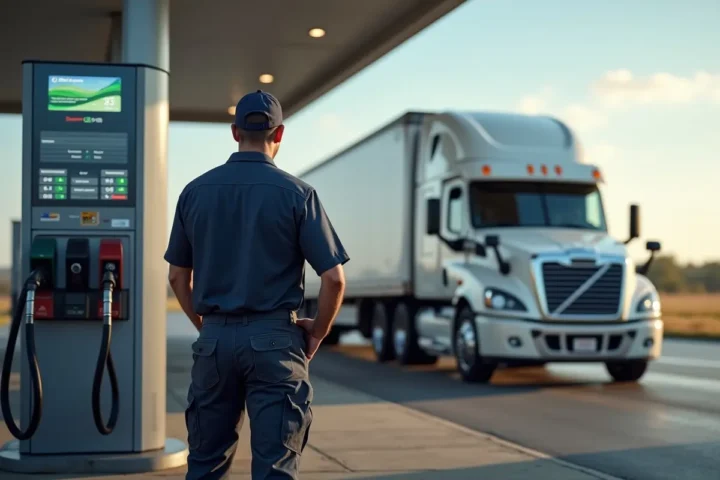Everything You Need To Know About Fuel Cards
Fuel costs represent one of the biggest expenses for businesses that rely on transportation. Managing these costs requires accurate tracking, strict control, and smarter payment methods.
Fuel cards provide a practical solution by replacing cash or corporate credit cards with a system built specifically for fuel management. They simplify payments, deliver real-time reporting, and reduce the risk of misuse.

Companies across logistics, delivery, construction, and rental industries already rely on fuel cards to keep operations efficient. Understanding how fuel cards work, what benefits they bring, and which type suits your business is essential before choosing one.
What Is A Fuel Card?
A fuel card is a payment card designed for purchasing fuel at authorized stations. Instead of using cash or personal credit cards, businesses issue these cards to drivers or vehicles for controlled fuel spending.
Every transaction made with a fuel card is recorded with details like time, location, amount, and mileage. This information helps companies monitor fuel usage and identify patterns in driver behavior.
Fuel cards are often called fleet cards because they are commonly used by companies managing multiple vehicles. From small delivery vans to large trucking fleets, they provide a reliable way to handle fuel expenses efficiently.
What Is A Fuel Card?
A fuel card is a payment card designed for purchasing fuel at authorized stations. Instead of using cash or personal credit cards, businesses issue these cards to drivers or vehicles for controlled fuel spending.
Every transaction made with a fuel card is recorded with details like time, location, amount, and mileage. This information helps companies monitor fuel usage and identify patterns in driver behavior.
Fuel cards are often called fleet cards because they are commonly used by companies managing multiple vehicles. From small delivery vans to large trucking fleets, they provide a reliable way to handle fuel expenses efficiently.
What Are The Features Of Fuel Cards?
- PIN protection: Each card requires a personal identification number to authorize purchases.
- Spending limits: Businesses can set daily, weekly, or monthly caps.
- Product restrictions: Cards can be configured to allow only fuel purchases and block convenience store items.
- Driver identification: Transactions capture driver ID, vehicle ID, and mileage for full traceability.
- Mobile apps: Drivers can locate the nearest participating fuel stations using GPS-based applications.
- 24/7 reporting: Managers access real-time data on every transaction.
What Are The Types Of Fuel Cards?
Fuel cards are available in different forms, and each type is designed to serve specific business needs. The choice depends on how much coverage, flexibility, and control a company requires.
Branded Fuel Cards
Branded fuel cards are linked to a single fuel provider. They usually offer better discounts and loyalty rewards but can only be used at that provider’s stations.
Multi-Network Fuel Cards
Multi-network fuel cards are accepted at a wider range of fuel stations. They provide flexibility for drivers traveling across different routes and regions.
Universal Fuel Cards
Universal fuel cards work at nearly all stations that accept standard payment networks. They offer the broadest coverage but typically have fewer fuel-specific discounts.
Prepaid Fuel Cards
Prepaid fuel cards are loaded with a fixed balance before use. They give businesses tight control over spending and work well for small fleets or temporary operations.
Fleet-Specific Fuel Cards
Fleet-specific fuel cards come with advanced controls such as driver PINs, vehicle restrictions, and detailed reporting. They are best suited for larger fleets that need close monitoring and integration with fleet management systems.
Each type of card serves a unique purpose. Smaller businesses often find prepaid cards effective, while larger fleets rely on multi-network or fleet-specific cards for greater oversight.
How Do Fuel Cards Work?
To use a fuel card, a business first sets up an account with a provider and assigns cards to specific drivers or vehicles. Each card is linked to the company account, so every purchase is automatically recorded.
When a driver refuels, they swipe or insert the card at a participating station just like a debit or credit card. The system checks the details instantly, approves the purchase, and logs the transaction.
All fuel card activity is collected into digital reports and consolidated invoices that the business receives on a regular schedule. This process eliminates manual receipts, reduces paperwork, and keeps spending transparent.
Why Are Fuel Cards Important?
Fuel cards matter because they give businesses better control over one of their biggest expenses. They help companies cut down on costs, simplify operations, and keep drivers accountable.
- Lower fuel expenses: Fuel cards often come with discounts, rebates, or fixed-price agreements that reduce overall fuel costs. According to Matrackinc, a fleet management provider, fleets that adopt fuel cards can save up to $2,000 per vehicle each year.
- Better spending control: Each transaction is tied to a driver or vehicle, which prevents unauthorized purchases and keeps budgets on track.
- Simplified administration: Instead of handling stacks of receipts, managers get a single consolidated invoice with all fuel transactions in one place.
- Accurate data: Detailed reports on fuel consumption, mileage, and spending give businesses insights they can use to improve efficiency.
- Improved accountability: Drivers know their fuel usage is tracked, which reduces wasteful refueling or misuse of company funds.
How To Get Fuel Cards?
Getting a fuel card is a simple process, but it requires businesses to evaluate their needs carefully before applying. The steps involve researching providers, submitting applications, and setting up the right controls.
Step 1: Identify Business Needs
Start by looking at how your fleet operates. Consider factors like fleet size, average monthly fuel spend, and the routes your vehicles take.
Step 2: Compare Fuel Card Providers
Review different providers and what they offer in terms of coverage, discounts, and reporting tools. Make sure the network matches the areas where your drivers usually refuel.
Step 3: Submit An Application
Most providers allow businesses to apply online with basic company details. The approval process usually checks business information, vehicle count, and credit history.
Step 4: Assign Cards To Drivers Or Vehicles
Once approved, cards are issued and can be linked to either specific drivers or vehicles. This step helps businesses track transactions more accurately.
Step 5: Set Up Spending Controls
Configure the cards with spending limits, PIN protection, and product restrictions. These controls ensure that the cards are only used for fuel and within approved budgets.
Step 6: Monitor And Review Usage
Use the reporting tools that come with the cards to review fuel spending regularly. Monitoring ensures the system is being used correctly and identifies areas where costs can be reduced.
What Are The Benefits And Challenges In Fuel Cards?
| Benefits | Challenges |
| Fuel savings through discounts and rebates | Monthly or transaction fees increase costs |
| Better cash flow with consolidated invoices | Limited coverage depending on provider network |
| Accurate reporting on fuel consumption | Risk of misuse if controls are not set properly |
| Fraud prevention with PIN and card controls | Dependency on provider’s reporting system |
| Easier tax compliance with digital receipts | Approval may require strong business credit |
| Improved driver efficiency and time savings | Not all cards offer equal discounts or features |
Conclusion
Fuel cards have become an essential tool for businesses that rely on transportation, helping them manage fuel costs with greater accuracy and control. They replace traditional payment methods with a system that tracks expenses, prevents misuse, and improves efficiency across fleets of any size.
By offering savings, real-time data, and simplified administration, fuel cards give companies both financial and operational advantages. At the same time, businesses need to weigh the challenges, like fees and provider limitations, before choosing the right option for their needs.


